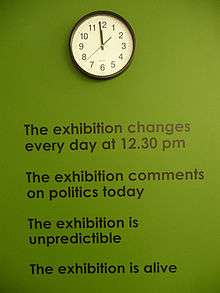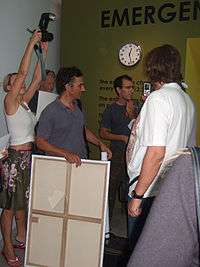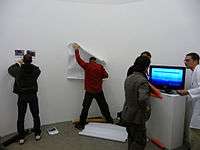Emergency Room (art)






Emergency Room is an art exhibition format devised by Thierry Geoffroy for artists with desire to engage quickly in the current debate. Artists are invited to contribute with art works that are produced daily in response to ongoing social issues, contributing to a constantly changing exhibition. The format avoids the need for an artist to wait months or years before being able to exhibit their art. Emergency Room exhibitions have been held in a number of locations globally.
Emergency Room format
"Artists, audience and media have been fighting for weeks in order to get to see and participate in the new and innovating exhibition that with its "art of the news" puts the art institution itself to debate. Reuters, The New Yorker and the TV-channel ABC News are some of the leading media that have brought the story about the original exhibition, and at P.S.1 more than a thousand visitors per day have been seeing it…" said Danish newspaper Weekendavisen in March 2007.[1]
Emergency Rooms are "carefully prepared environment[s] for hectic bursts of creation".[2] Emergency Rooms can take place in several places across the world at the same time. When art institutions wish to host the Emergency Room format they are given a license to produce a version of the format.[3]
The Emergency Room format involves a system which is taught to the participating artists by Emergency Room staff. The system requires the artwork of the previous day to be removed daily (normally around 12.30 p.m.) and replaced by fresh artworks. Geoffroy calls this central element of the process "The Passage".[3] The number of artists turning up for the Passage will vary, sometimes with nobody showing up. Other days the news of the day will stimulate responses from the artists and participation in the Passage increases.
Emergency Room can be combined with the 'Delay Museum', a nearby exhibition space where yesterday’s artwork is archived and shown.[3] This museum is no longer contemporary in the sense of the word used by Emergency Room. This delay of opinions and reactions are preserved. Geoffroy describes this as a critical way of thinking about contemporary art, with The Delay Museum becoming a place for studying the aesthetics of the fast moving 'emergency'.[2] It is recorded externally by media coverage and internally usingf blogs, webcasting and artist interviews by the Emergency Room staff.[2]
Geoffroy describes the Emergency Room as a format where artists can "train their awareness muscle", encouraging experimentation and artistic daring.[4]
Contributing artists 2006 - present
The Emergency Room events involve large numbers of local and overseas artists. By November 2008 over 150 artists had been involved in the format in a number of locations internationally.[5]
The format has been activated in:
- MoMA PS1, New York City (2007)[6] involving 30 artists, changing the entire display at 12.30pm each day.[7]
- University of Fine Arts, Hanoi, Vietnam (2009) involving 25 local and overseas artists.[8] The event coincided with a Danish State visit to Hanoi in November 2009.[9]
- European Culture Congress, Wroclav (2011), involving 18 artists.[10]
- Naples : PAN - Palazzo delle Arti Napoli (2009)[11]
- Athens : Ileana Tounta Contemporary Art Center (2007)[12]
- Paris : Galerie Taiss (2008).[5]
- Berlin : Galerie Olaf Stueber (2006) .
- Copenhagen : Kunsthallen Nikolaj ( 2006).
References
- ↑ Nikolaj M. Lassen, "Art = Retard" (in Danish), Weekendavisen, 30 March 2007.
- 1 2 3 The Emergency Room Format, Emergencyrooms.org. Retrieved 2013-04-30.
- 1 2 3 Emergency Room Hanoi, artinasia.com, October 2009.
- ↑ "Q&A: Alternatives – Thierry Geoffroy". Cultural Development Consultation. Retrieved 12 October 2015.
- 1 2 Thomas, Cyril (13 November 2008). "Le remède à la morosité : EMERGENCY ROOM (in French)". ArtNet.fr. Retrieved 2013-04-25.
- ↑ Emergency Room, MOMA PS1.
- ↑ Dewille, James (21 February 2007). "Live From N.Y., It's Yesterday's News". Columbia Daily Spectator. Retrieved 2013-04-25.
- ↑ "Experimental exhibition opens in Hanoi". Hanoi Times. 3 November 2009. Retrieved 2013-04-25.
- ↑ "At Vietnam University of Fine Arts", E-flux, 1 November 2009.
- ↑ Emergency Room, European Culture Congress 2011.
- ↑ Emergency Room Napoli di Thierry Geoffroy/Colonel (in Italian), Comune di Napoli.
- ↑ Emergency Room (press briefing), Ileana Tounta Centre for Contemporary Art.
External links
- Format Emergency Room at MOMA / PS1 New York. Report from ABC News 2007
- Emergency Room Dictionary, published by Revolver Publishing
- "THIERRY GEOFFROY / AKA COLONEL: EMERGENCY ROOM DICTIONARY" by The Royal Danish Academy of Arts
- Format Emergency Room at MOMA / PS1 New York. Report from Reuters 2007 The art of news
- The Brian Lehrer Show "Where art and Journalism Collide" (mp3, WNYC) PS1/MoMA, New York, 2007
- Format Emergency Room in Paris / Emergency Case. By Natalie Hegert, 2008
- Emergency Room - Galerie Taiss - Paris
- Interview with Colonel on Kopenhagen.dk 2008
- http://www.kunsten.nu/artikler/artikel.php?thierry+Geoffroy+emergency+room
- Format Emergency Room Hanoi from 36pho TV news